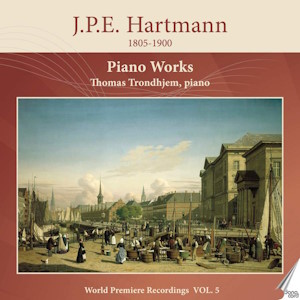
J. P. E. Hartmann (1805-1900)
Piano Works Volume 5
Fantasy in G minor, op. 7 (1831)
Six Fantasy Pieces, op. 54 (1855)
Two Character Pieces, op. 25 (1839)
Grand Waltz in E Flat Major (1826)
Midsummer’s Waltz in A Major (1859)
Slow Waltz in E Flat Major (1847)
Eight Caprices, op. 18 (1835)
Thomas Trondhjem (piano)
rec. 2023, Concert Hall, Holstebro Music School and Music Academy, Holstebro, Denmark
Danacord DACOCD968 [79]
This is the fifth volume of piano music by the Danish composer J. P. E. Hartmann. For details of his life and achievement, see my review of Volume 1 of the cycle. (Here are my reviews of the other instalments: Volume 2 ~ Volume 3 ~ Volume 4). This disc explores a few collections of pieces and three waltzes.
I was disappointed again that there is precious little commentary on the music. This is little-known repertoire, at any rate to listeners in the UK. Claus Byrith’s liner notes give a long and detailed introduction to Hartmann; it includes an assessment of Britain’s military action in Denmark during the Napoleonic wars, and the contemporary political situation with Germany. The notes make this general statement: “the piano works […] occupy a significant place in [Hartmann’s] production. He wrote several sonatas and […] a number of short pieces intended for use not only in the concert hall, but also in the drawing room.” A brief descriptive note on each work would have been helpful and rewarding.
The Fantasy is, to my ear, slightly unbalanced pianistically. It flits across multiple moods and fancies without ever settling: maybe that is its point?
The Six Fantasy Pieces encourage much beautiful pianism. I was particularly taken with No.1 in F sharp major, marked Allegro poco moderato pastorale. Less remarkable is the third, Canto Marziale Religioso; it seems to me laboured. More fun is No.4, a little scherzo-like number played Allegro molto assai. I think that this set ought to be performed together: the pieces are too slight to be played individually.
The first of the waltzes, Grand Waltz, is a highly infectious romp, with thoughtful episodes. Hartmann penned it when he was 21. The Midsummer’s Waltz, which came thirty-three years later, gently nods to Chopin and Weber. The darker Slow Waltz, at a mere 43 seconds, ends before it really gets going.
Robert Schumann admired the charming Eight Caprices – but considered that they had “intellectual vigour” but lacked melodic interest. Here, Danish pianist Thomas Trondhjem has teased out the tuneful aspects of these pieces. I was particularly impressed with the bewitching No.6 in F major, but they all are interesting and delightful.
The liner notes say that Hartmann heeded Schumann’s analysis when he wrote Two Character Pieces. They are full of charm and occasional magic.
While the booklet (in Danish and English) omits musical analyses, it is well produced. It contains an interesting contemporary painting by Heinrich Hansen of the Christiansborg Palace from Højbro Square in Copenhagen. There are also sheet music scans, plus portraits of the composer and the soloist.
Thomas Trondhjem is highly regarded for his “immense” repertoire of classical through to modern music. He has released many discs with music of Danish composers, including Friedrich Kuhlau, C. E. F. Weyse and Fini Henriques. He is a teacher at the Music Academy of Jutland West and, from 2004, professor at The Royal Academy of Music in Aarhus. He is widely respected in Denmark as a chamber musician and accompanist for singers. He is an outstanding advocate for Hartmann’s piano music. He brings technical skill, nuanced playing and academic erudition to this programme. Danacord’s sound recording is, as always, clear and vibrant.
J. P. E. Hartmann’s compositional models are plentiful. They include Robert Schumann, Felix Mendelssohn, Frédéric Chopin, and Scandinavian folk song. One individual who struck me as a major influence is the Hungarian pianist, teacher and composer, Stephen Heller. Commentators have remarked on nods to Edvard Grieg, and more tellingly, intimations of Carl Nielsen. It is up to the listener to decide if Hartmann has replicated or synthesised his prototypes. In any case, this music is full of interest and gives considerable pleasure. Listen slowly, one number or collection at a time. It is rewarding music.
John France
Help us financially by purchasing from



















